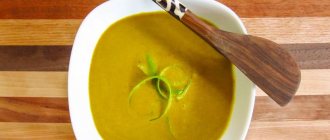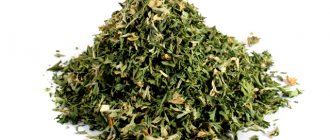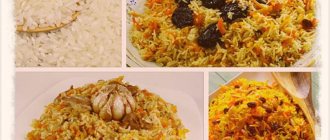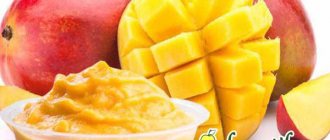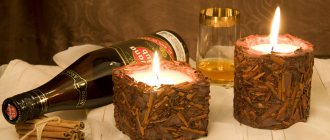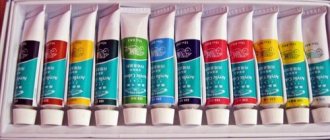So, are turmeric and curry really the same thing? They may look similar in appearance, especially if you are not very experienced in knowing Indian spices. However, they are not the same thing. Why? Read on.
Turmeric is a member of the ginger family, has a slightly bitter taste, and gives dishes (and clothing) a bright yellow color. If we talk about spices, then this is one spice, not a mixture.
Turmeric: root and powder
Curry is a mixture of spices (masala, in Indian), which, among others, includes turmeric. Other main ingredients in curry include cumin and chili pepper. There are different types of curry: some are mild, some are hotter.
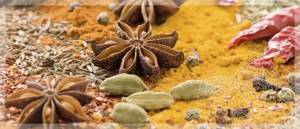
Curry contains various spices, including turmeric
Because Curry already contains some amount of turmeric, naturally it also has its beneficial properties in proportion to the amount of turmeric in it. But if we talk, in general, about the mineral and vitamin composition, then curry, of course, differs from turmeric, because besides it, it also contains other spices.
Curry seasoning composition
There is no specific clear standard.
Main ingredients:
- turmeric;
- caraway;
- coriander;
- red cayenne pepper.
The most commonly used additional ingredients are:
- fenugreek;
- cinnamon;
- carnation;
- nutmeg;
- anise;
- ginger;
- cardamom;
- garlic;
- mustard powder.
100 g of product contains:
- protein - 14.29 g;
- fats - 14.01 g (of which saturated fatty acids 1.648 g, monounsaturated fatty acids 8.78 g, polyunsaturated fatty acids 3.056 g);
- carbohydrates - 55.83 g;
- dietary fiber - 53.2 g.
Minerals: potassium, calcium, phosphorus, magnesium, sodium, iron, selenium, zinc, copper.
Vitamins B1, B2, niacin, B6, B12, A, D, C, E, folic acid derivatives.
All these additives are to taste! However, the classical basis has not changed for several decades.
Important! When buying a ready-made curry mixture in a supermarket or market, it is worth studying the composition. There is no need to buy an option that contains starch, salt, or any chemical flavor enhancers. It's not curry anymore!
By the way, in India this seasoning is prepared right before preparing dishes to which they plan to add this spice. This way you can get a rich taste without losing the aroma and make a curry that is ideal for a specific dish.
And yet, in India, curry is included in many dishes. Anyone who has tried Indian cuisine knows that the delicate spicy aroma of curry is always associated with dishes from this unique country.
Experienced cooks probably know what this seasoning looks like. But it wouldn’t hurt to give a description of this wonderful culinary additive. So, curry is a bright yellow powder. Although there is also curry paste. Color can vary from deep yellow to lemon or iridescent orange. It all depends on the type of curry.
The fact is that this seasoning is made in different countries. Somewhere it is believed that the main ingredients should be peppers. Elsewhere, curries are produced where turmeric plays a leading role. Somewhere many other components are added to the curry, and somewhere they make a classic version of the mixture without violating the strictness of the base.
Turmeric and turmeric - benefits

The benefits of turmeric are directly related to the dose of active substances consumed. Research suggests that when using a spice (turmeric or curry powder), the absorption and bioavailability of curcumin is quite low. The fact that in traditional Indian cuisine the spice is added to food in large quantities also plays a role, while in adapted recipes there is much less turmeric.
If you decide to take turmeric to improve your health, it is recommended to either use a few grams of freshly ground powder daily or take medications containing turmeric. It should be separately noted that taking curry powder in large quantities can cause stomach problems - both nausea and diarrhea.
How to take Turmeric capsules?
Before purchasing turmeric capsules, you should carefully read the information about the composition. The best combination is considered to be a combination of turmeric with piperine (black pepper extract), or with soy lecithin, as well as with essential oils - in this case, the effect of the drug will significantly exceed the effect of ordinary table seasoning². Capsules should be taken 2-3 times a day, with food.
Turmeric: Recommended Dosages
- 500 mg curcumin and 30 mg piperine - 3 times a day
- 500 mg curcumin with essential oils - 2 times a day
- 200-500 mg curcumin with soy lecithin - 2 times a day
Contraindications
Contraindications for taking turmeric (primarily in tablets and not as a seasoning) include gallstones, blockage of the bile ducts and similar diseases; diabetes; as well as gastritis and other problems with stomach bleeding³. Taking curcumin for treatment is not recommended during pregnancy and lactation (permissible in the form of moderate doses of curry).
In men, taking large doses of turmeric can cause a decrease in testosterone levels and impaired sperm motility. Among other things, curcumin may impair iron absorption and is not recommended for a number of conditions. Symptoms of curry overdose include weakness, dizziness, nausea and various digestive disorders.
What is it: description of both spices
There is no point in identifying these two spices - they are not the same thing! The definitions of each product will help you understand the difference.
Curry is turmeric combined with other spices; the finished powder can contain from five to ten different components. Most often, it consists of the following ingredients:
- Chilli;
- Carnation;
- Fenugreek and fennel;
- Coriander and cumin;
- Cardamom and ginger.
In India, the leaves of the curry tree of the same name are actively used, but the recipe for the mixture was invented by British chefs! It has a rich taste and gives the finished dish a warm yellowish tint.
Turmeric
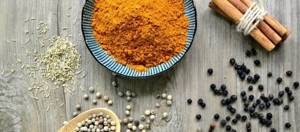
Turmeric is the crushed root of a plant of the same name from the Ginger family. The roots are boiled, dried and ground to a powdery state. In India, this spice is incredibly popular and is included in many dishes.
It is actively used in cooking and medicine/cosmetology, helps against colds, and improves skin tone.
Has the following properties:
- Anti-inflammatory and bactericidal;
- Analgesic and diuretic;
- Choleretic and antispasmodic.
However, definitions will not be enough to understand that two spices are not the same thing. Let's talk about the significant differences!
Useful properties and contraindications
The beneficial properties of turmeric, which serves as the main ingredient in many oriental seasonings, have long been known in folk medicine. Scientific research confirms that curry seasoning is valued not only as a culinary masterpiece. It has a healing effect:
- strengthens the heart and blood vessels;
- reduces joint pain, accelerates bone regeneration after fractures;
- has an antibacterial effect;
- reduces the risk of cancer;
- reduces inflammation;
- gently reduces blood glucose levels and prevents surges;
- serves as a source of iron, reduces cholesterol levels, is useful for weight loss;
- stimulates the nervous system, improves mood.
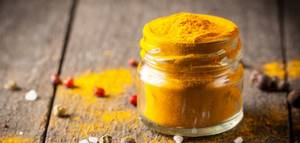
Curry is a strong anticoagulant. The use of spices with blood thinning drugs is contraindicated. It is not advisable to take in case of cholelithiasis, individual intolerance to the components of the mixture, or chronic diarrhea. It is better not to use a product that has a sharper taste if you have gastritis or stomach ulcers.
What is turmeric?

Turmeric is a genus of plants in the ginger family, used both for cooking and as a medicine. In most cases, we are talking about the use of dried and ground roots of the long turmeric plant (curcuma longa), known as “turmeric”. Turmeric is also a key ingredient in various spice mixtures called “curries.”
In Ayurveda, the ancient Indian teaching of health and yoga, turmeric is considered a natural antibiotic and immune booster. Thanks to its bactericidal and antimicrobial properties, the spice reduces the risk of poisoning from low-quality food products - which is extremely important in India with its hot and humid climate. It is for this reason that Indian cuisine makes extensive use of curry.
Modern scientific research confirms the health benefits of turmeric. Curcumin has been shown to significantly reduce inflammation in the body and also increase levels of endogenous antioxidants¹. A number of studies indicate the positive effect of turmeric on relieving pain from osteochondrosis, as well as its ability to normalize cholesterol levels and blood sugar.
What is curcumin?
Curcumin is a polyphenol (a natural antioxidant) and the active ingredient in turmeric that has a bright yellow color. In the food industry it is known as E-100 and is used both as a spice and as a coloring agent - including coloring cheese, yogurt, potato and corn chips, cookies, salad dressings and margarine.
You can also buy curcumin (essentially turmeric powder) in the form of a dietary supplement - in capsules and tablets. It is believed that the use of curcumin extracts can improve the health effects of the substance, since it is easier to control the dosage and quality of the supplement. Note that in the form of a seasoning, turmeric has a fairly low absorption rate - unlike curcumin in tablets.
What turmeric does for your health¹:
- Neutralizes free radicals
- Reduces the amount of inflammation in the body
- Helps heal wounds and improve skin condition
- Reduces pain in osteochondrosis
- Combats symptoms of depression
- Normalizes insulin levels in the blood (useful for weight loss)
- Increases good cholesterol levels
- May slow the progression of Alzheimer's disease
Differences
There is a difference between curry and turmeric - even the most inexperienced cook can discern it. Even if at first glance the seasonings seem the same, there are differences and they are obvious! Let's go through the list and look into the details in more detail?
| Sign | Curry | Turmeric |
| Taste | More intense, with hints of spice and pungency | Spicy but not hot |
| Color | Yellow color with a darkish tint, no brightness of colors | Bright and rich yellow |
| Aroma | Soft and rich aroma, notes of freshness predominate | Hot and spicy, has notes of bitterness |
| Application | Exclusively in cooking | In addition to cooking, it is used in cosmetology and medicine. |
| Compound | Less iron and magnesium | Less vitamin E |
But the main difference between turmeric and curry is its composition. If the first seasoning is used in its pure form and is a rhizome crushed into powder, then the second is a combination of several ingredients. Contains about ten different spices!
We figured out how turmeric differs from curry - do the two different spices have similar features? Let's try to figure it out!
What is the difference?
Let's look at the difference between spices.
Appearance and smell
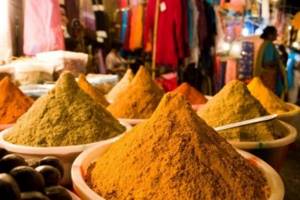
The smell of each spice is individual and unique; they cannot be confused. Thus, turmeric has a more pungent, spicy aroma with notes of bitterness and pungency, while curry has a soft, balanced, rich aroma with refreshing notes. The heat level of the curry is determined by the amount and type of pepper added. Mild powders usually contain ginger or black pepper, while the hot spice mixture usually contains red chili.
Curry is a mixture of spices that includes from 5 to 10 ingredients.
Curry seasoning usually includes spices such as: turmeric, cumin, coriander, ginger, cardamom, cloves, fennel, nutmeg, fenugreek, red and black pepper.
This composition is not universal, since manufacturers can mix spices at their discretion. Curry can consist of either 5-6 or 10 ingredients. However, at the heart of this powder 4 ingredients are indispensable, these include :
- turmeric , which makes up 30 percent of the seasoning and gives it its corresponding yellow color;
- coriander – occupies 27 percent, gives the seasoning an unsurpassed aroma;
- cumin - occupies 8 percent of the seasoning, often included in seasoning mixtures due to its nutty taste;
- chili pepper - 4 percent of the seasoning, this spice allows you to vary the taste of the seasoning from less hot to more spicy.
Turmeric is a monospice consisting of one ingredient . To obtain this yellow powder, manufacturers grind the turmeric rhizome until smooth.
Scope of application
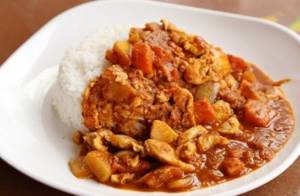
The curry spice mixture is created and used exclusively in the culinary field, while turmeric is distinguished by its breadth of use and versatility.
Curry is added to various dishes , for example, it perfectly complements rice dishes, it is perfectly combined with meat, fish, and vegetables. The seasoning is used as the basis for savory sauces, and is sometimes added when creating various drinks and cocktails to give them a special piquancy in taste, color and aroma.
Turmeric powder is also used to prepare various dishes:
It is often added to the well-known pilaf, which gives it a yellow color and a spicy taste.
The spice is popular primarily because of its beneficial properties and the presence of a large amount of vitamins.
Turmeric contains curcumin, a potent component that can affect the human body even in small doses, so you need to be careful with the spice!
Adding turmeric to food has a good effect on digestion : digestion and elimination of food residues occurs much faster, cravings for unwanted harmful foods are reduced and the load on the liver is reduced. As a result, there is an improvement in well-being and appearance.
Traditional medicine and cosmetology

If curry is more intended for use in cooking, then turmeric is widely used in folk medicine and cosmetology. It acts as a natural antibiotic with many healing properties. These include:
- improving digestion and restoring intestinal microflora;
- acceleration of metabolism and removal of cholesterol;
- providing an anti-inflammatory and analgesic effect;
- improving the body's immune system;
- prevention of Alzheimer's disease, etc.
Traditional medicine has long proven the effectiveness of the spice, so it is used in the treatment of many diseases.
The healing properties of the seasoning are obvious, but it is extremely important to correctly introduce it into the diet and use it for its intended purpose. Excessive consumption may negatively affect health.
Turmeric is also actively used in cosmetology . It is included in some cosmetics as an additional ingredient. For example, it is used in homemade cosmetic masks and wraps.
Masks using turmeric give hair a well-groomed appearance, promote rapid growth and strengthening. As a facial treatment, mixtures are made from powder with various oils and lemon juice. This mixture allows you to narrow pores, get rid of inflammation and rashes, refresh and improve the tone of your facial skin.
How to make curry at home?
Just as an artist paints his canvas, so each cook has his own curry seasoning, according to his own taste, depending on what kind of dish he should get. You can easily make curry at home.
The list of required components includes:
- ground coriander (4 tsp),
- turmeric (2 tsp),
- cumin (1 tsp),
- black pepper (1 tsp),
- ground red pepper (1/2 tsp),
- cardamom (1/2 tsp),
- cinnamon (1/4 tsp),
- ground ginger (1/4 tsp).
All homemade curry ingredients are mixed and crushed.
Similarities
Turmeric and curry seasonings are not the same thing, as we found out above. But both spices have some similar data. Let's look at which ones exactly?
- Same consistency - powdery,
- A similar color is a yellow tint at the base;
- Both spices come from India;
- Thanks to curcumin, contained in both spices, cell damage from free radicals is reduced;
- Other similar beneficial properties are the ability to speed up metabolism and improve well-being, reducing the risk of developing cancer;
- The common denominator is stimulation of the appetite and stimulation of the digestive system;
- Both spices contain alpha-tocopherol, which regulates the functioning of all body tissues.
It’s impossible to answer unequivocally which is better – turmeric or curry; too many parameters of the two seasonings differ significantly! Choose the right spice, focusing on your own wishes and needs - most importantly, buy proven products with rich taste and aroma and use strictly for their intended purpose, without overusing them!
Curry seasoning in cooking
One of the most popular seasonings in the world, therefore it is impossible to do without it in the kitchen. Most often used for cooking meat, vegetables, sauces, omelets, soups. It gives dishes not only a unique taste, but also a beautiful yellow color. Sometimes it is used to color and flavor dough.
The most popular dish is Chicken Curry. The seasoning can be used to prepare soups and salads, stews, sauces, meat and fish dishes. It is a good addition to shrimp, vegetarian dishes such as tofu, rice.
If you don’t have Curry seasoning, you can replace it with turmeric mixed with any of the available peppers, or add any aromatic spice.
You can also buy Tenduri Masala or Garam Masala. These seasonings have a similar composition, but different levels of spiciness. “Tenduri masala” is a mixture for cooking meat in the tandoor, it can be used without modification, it gives the dish a red color. To the Garam Masala mixture you need to add turmeric, which is not on the recipe list.
Curry leaves are difficult to replace. The use of lemon, lime, orange, and bay leaf zest will mask the absence of this ingredient.
Uses of turmeric and curry
The scope of use of spices is also their difference. Curry is suitable only for culinary purposes: this mixture is often added to Indian dishes. The powder goes well with meat, but it can be used when preparing food from fish and vegetables; some people like to mix it with yogurt. Can be added to marinades and sauces.
Turmeric in its pure form is used not only for cooking. In folk medicine, natural preparations are often prepared on its basis, helping to strengthen the immune system, speed up metabolism, and alleviate the condition of a number of pathologies of the heart, blood vessels, digestive organs, and urinary system.
The spice is also used in traditional medicine: it is part of a number of pharmaceutical preparations. Since the spice can react with drug components, you need to check with your doctor whether it can be used for treatment or eaten during the course of therapy.
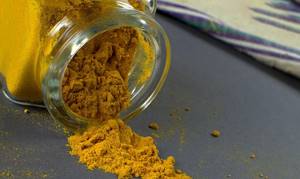
The spice is often used in cosmetology. Using masks based on it, you can improve the condition of the skin, hair, and nail plates. You can add a small amount of yellow powder to creams, shampoos and other cosmetics. However, care should be taken to avoid the development of undesirable reactions.
